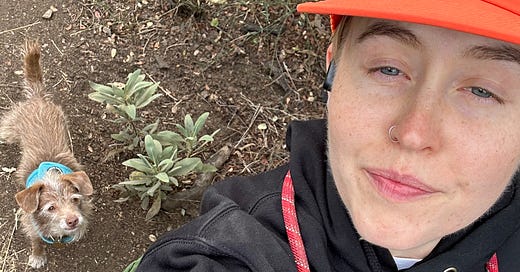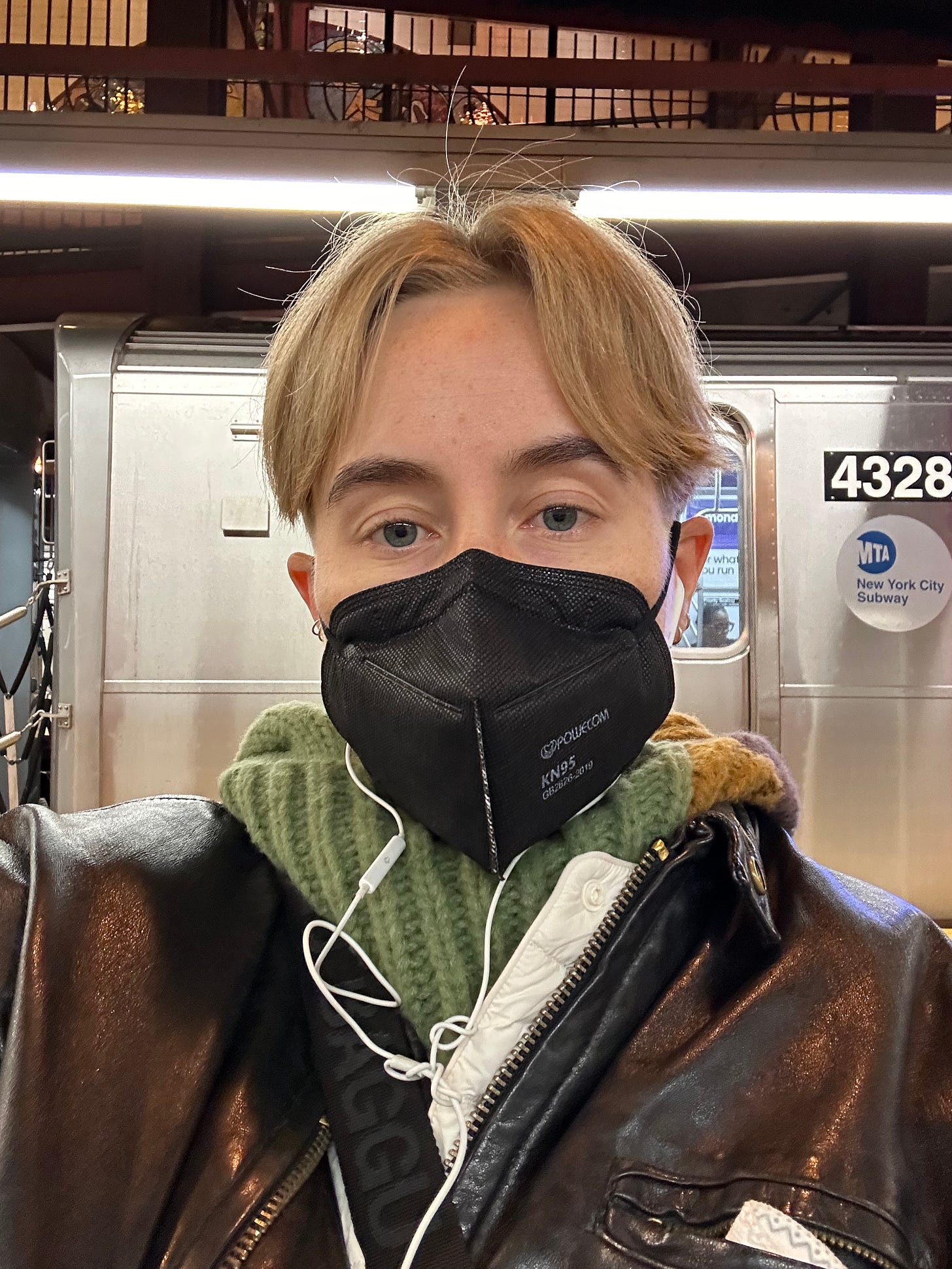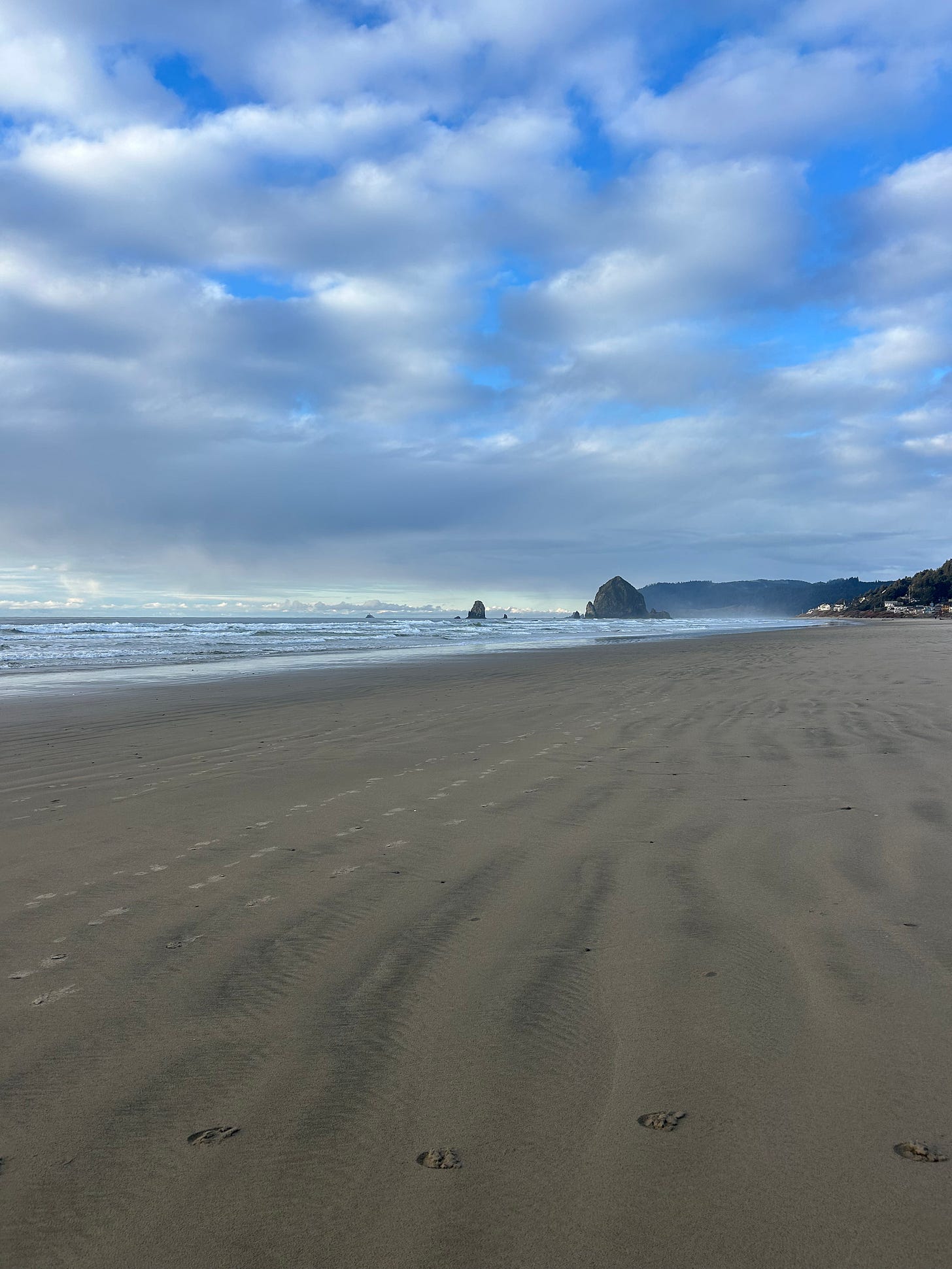I found my way to California in the fall of 2021, during a two month trip that I’d envisioned in the depths of the previous winter. I’d been sick (and stayed sick) with a novel virus, and I’d slowly begun to grapple with the idea that my hometown of New York City might no longer be as accessible to me. In my newly fatigued, immuno-funky,* and headache-ridden state, I anticipated issues with sensory stimuli, crowded indoor social events, long waits at subway stations, and cold walks home from the grocery store.
I was also feeling an immense amount of grief about the way New York City, and my own personal landscape, had changed. On a future visit years later, I would write in my diary that on every block I felt ghosts—of deceased or departed family members and friends, forgotten storefronts and homes, and the very events that had driven us out (an ongoing pandemic and rising rents that so often seemed to go unspoken). In that winter of 2020-2021, after close to a year of sitting in the same apartment, I yearned for an escape hatch. I felt so sad returning to the place where I’d fallen ill every day, and it felt too difficult to imagine rebuilding a life under these intense constraints.
So, I did a cliché thing, and spent money I didn’t have to go west. I landed in San Francisco in October of 2021 for a “trip,” and never returned home.
*I use this term lightheartedly to describe my immune system, which seems to struggle to fight off illness, since my 2020 Covid-19 hospitalization.
To be nimble
In California, I found an answer to many of my earlier problems. I could shut out city noise with quick trips to the desert, woods, or beach. I could drive to my errands, wheeling all my groceries directly to my car—more than halving the energy this chore used to take. I could gather with friends on spacious outdoor patios year-round, minimizing the threat of seasonal viruses that might take me out. In time, I made a home for myself in so-called Los Angeles, where I perfected my camping kit, hiked in Angeles National Forest, picnicked at the LA river, attended bonfire Shabbats, went to vigils at Echo Park, and bought baby lettuces at local farmers’ markets.
When I, infrequently, returned to New York, friends and family would sometimes incredulously ask if LA felt like home. I don’t think I could have answered with confidence until this year—now that I’ve had to contend with leaving it.
I have often prided myself on my ability to be nimble, despite my desire to plan in advance. A friend and former Body Politic comrade once told me I am good at accounting for all possible contingencies, and then adapting to what actually occurs. I agree this is my strategic strength, but lately, I wonder about its sustainability. I was sick when the fires hit, and while I managed to create an immediate escape route for myself and others’, as well as a continued patchwork of plans that would allow me to recuperate away from the city, I then had to account for the effort it took to do all that planning and travel. I am not as nimble as I might imagine, or perhaps, as I once was.
I’d argue that those who most need to flee in the midst or aftermath of a disaster are also often those who lack the resources—financial, energetic, or otherwise—to truly adapt to the multiple “contingencies” these situations present us with. I don’t think this is an especially radical argument. After all, disabled and unhoused people often die first during climate disasters. Where is their escape hatch?
Who “gets” to leave? Who “gets” to stay?
In the weeks since the fires erupted in LA, friends have asked me if I’ll return at all. Some have shared their own doubts about staying in the city in the wake of this major environmental hazard. Others have told me about people who are leaving for six months, or for good. It’s understandable, and still, these conversations sometimes feel tinged with a hint of secrecy—is it shame? The #StayInLA celebrity hashtag created this week is meant to keep entertainment jobs in the city, but it sometimes feels like a command for LA’s residents, as well.
In a recent session with my therapist, I realized this discussion felt familiar to ones that took place at the start of the Covid-19 pandemic, and guiltily recounted the intense anger I felt at that time, when I realized many of my peers had fled to far-flung locations, while I was stuck in my New York City apartment navigating the rollercoaster of Long COVID. Was I angry at them for leaving? Myself for not being able to? All of the above, as irrational as it is.
Anger at people for fleeing the scene of a disaster—especially if that scene is your “hometown”—is not new. In the immediate aftermath of 9/11, my own family left New York City for a couple of weeks to stay at my great grandmother’s home. I recall an email argument with cousins (from another part of the country) who accused us of abandoning the city when it needed us most. If my childhood recollection proves correct, this was a fight about clashing politics—who was more patriotic? My parents would go on to oppose the war, while these cousins would not. But, at the time, the conflict was distilled into a debate about who knew what was best for New York. We live here and you simply do not understand what we’re all going through, was the gist of my parent’s reply.
People in places like LA and New York City often assert the superiority of those of us born in these cities. And, we love to poke fun at the transient interlopers who pass through—“transplants,” as my family so often called them. We imagine these people descend from some upper middle class, white, suburban upbringing, and wander through our hometowns, clutching YETI mugs, with backpacks unknowingly unzipped, complaining about too much cream cheese on their bagels or too much spice in their tacos. When disaster hits—poof! They’ll be the first to go, we all tell each other, smugly.
But, is this really true? Doesn’t who stays have more to do with who can afford to stay, both in terms of money and health status? I’ve often said that I’m not sure how young people survive in New York City these days, without NYC-based family, independent wealth, or some combination of both. So, even if some of those “transplants” do end up evaporating after a disaster, is it really because they aren’t committed enough, or never understood the culture in the first place? After all, most of the “transplants” I knew who left New York City after 2020 were queer artists/gig economy workers without financial safety nets. Aren’t these the people we like to say these cities are a haven for?
Migration as human right
On Instagram recently, Allen Salway, a queer Navajo, Tohono O’odham, Oglala Lakota writer and cultural curator from the Navajo Nation, posed a question to his followers, seemingly in response to new threats against LGBTQ+ people, immigrants, and other marginalized groups. The post read, “LET’S BE HONEST: WHO IS CONSIDERING LEAVING THE SO CALLED UNITED STATES?” The comment conversation that ensued was one of the most compassionate I’ve seen on this subject. Someone talked about having migrated in the past due to health issues. Another wrote: “I don’t think any marginalized or threatened community should feel compelled to stay if they are able and want to go.”
Salway noted in the post itself that migration is a human right: “It’s only recently we’ve been forced to stay in certain areas.”
Last year, I wrote an article on people with Long COVID and related conditions who were migrating to escape environmental triggers, like extreme heat, seasonal allergies, and mold. One woman I spoke to—who was experiencing severe Mast Cell Activation Syndrome (MCAS) reactions in Austin, Texas—left that city with her family for Colorado. Another went from Texas to Michigan to escape the heat. A third dreamed of leaving their hometown of New York City, but called the cost of relocating “prohibitive.”
In the Victorian era, sick people were often sent away to convalesce. They called it a “change of air,” and some scholars argue this approach gave more respect to the lengthy, nonlinear form healing so often takes. But, not everyone got to recover at the seaside, like I have been doing recently. As in today’s world, migration, refuge, and safe convalescence are not escape hatches that are open to all. Certain resources are often needed to grease the wheels. And yet, pandemics, climate disasters, and policy changes can make staying feel impossible—especially when you lack those same resources.
Coming home
After 9/11, my family returned to New York City, and we stayed. It was the city where my parents and many of my grandparents had grown up. I imagine leaving for good felt unimaginable—both logistically and culturally.
Cultural attachment to place can feel very real, even when it is built on bizarre mythologies (as is often the case in nations born from brutal colonization). The ways of life we adopt, the communities we create, and the daily rhythms we inhabit weave a backdrop many of us come to call home. When danger encroaches on these little worlds, the path forward is almost always muddled.
In an episode of Parched, the 2023 Colorado Public Radio podcast about those of us who rely on water from the increasingly dry Colorado River, a third generation farmer in Yuma, Arizona, grapples with how to survive the growing water scarcity: “The easiest thing to do is to sell…but that's not the culture and the way of life we want.” All over the world right now, people are facing choices between hunkering down in a place that feels increasingly inhospitable, and leaving behind what once felt familiar.
Since the fires, I have struggled with a kind of guilt and confusion about spending time away from LA—a place that feels homier than ever now that I’ve left it. I’ve found myself watching bad sitcoms set in the city just to get a glimpse of Echo Park. Everyone I talk to has been deeply affirming of my decision to spend time away, urging me to focus on my health in a place where there are fewer variables, and expressing gratitude that I have this option. And yet, I hear my own angry voice calling back at me from the depths of 2020—sneering at my lucky escape hatch, and pointing out the fact that so many others don’t have one.
I plan to return to LA, to reconvene with the communities I’ve been in touch with virtually, and I also plan to consider more time outside of it this year. If my experience of past hazardous events and public health crises has taught me any lessons, I’d say:
It takes time to fully understand the impact of unprecedented events, and the more you can mitigate your exposure during that fact-finding mission, the better.
Sometimes you have no escape route. Other times you do. Sometimes, you will really need one, regardless of what is possible. It doesn’t help much to judge yourself for being in any of these situations.
No place is insulated from all dangers, and most places can feel like some sort of home.
I’ve never known how to respond when my New York family and friends ask me if LA feels like home, but I’ve always had the same answer when they ask if I’ll stay there forever: After the Covid-19 pandemic triggered a cross-country move I could never have imagined, I don’t think I can say I’ll live anywhere indefinitely again. It feels foolish to imagine a future of stasis for any of us—and my own way of contending with this is to try to stay nimble, at least within my daydreams.
For now, I am grateful for my escape hatch, and grieving for everyone else who didn’t get one. In search of another type of escape, I find myself reaching for the remote. I want to watch that bad LA sitcom. I guess I miss home.
Stay safe out there.






